You might be considering if the bulk and weight of a 1-4x scope is worth it in comparison to a compact red dot sight.
With such low magnification, it probably doesn’t offer that much more than a red dot, right?
You’ll be able to answer this yourself by the end of the comparison.
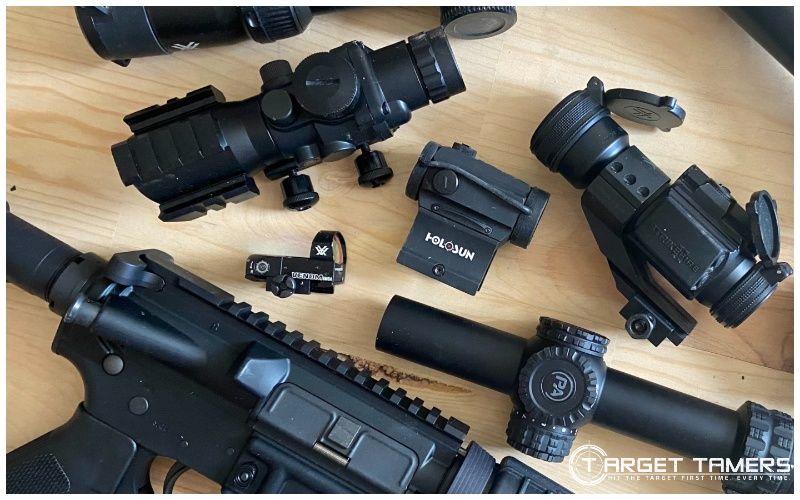
On average, the 1-4x scope can perform much like a red dot at 1x, but it has additional benefits of variable magnification, an optical system that can be better for astigmatism, and a reticle that's visible without illumination. However, the red dot is known for speed, ease of use, and durability.
I compare 1-4x LPVO features against a red dot sight to determine how they differ, and which could be best for your needs.
Why Trust Us?
After hundreds of hours of hand-testing scopes and red dots in the field and at the range, and thousands more hours researching and writing about them, we feel we earn the title of experts when it comes to optics!
We purchase as many of the optics for our tests as possible, and run them through their paces to make sure they will perform at the range and in the field.
Our combined decades of experience from plinking, target shooting, hunting, competing, and then mounting, sighting-in, and trouble-shooting has been integral in putting together this comparison guide of 1-4x scopes VS red dot sights.
Get the inside scoop on how we test optics here.
1-4x LPVO VS Red Dot
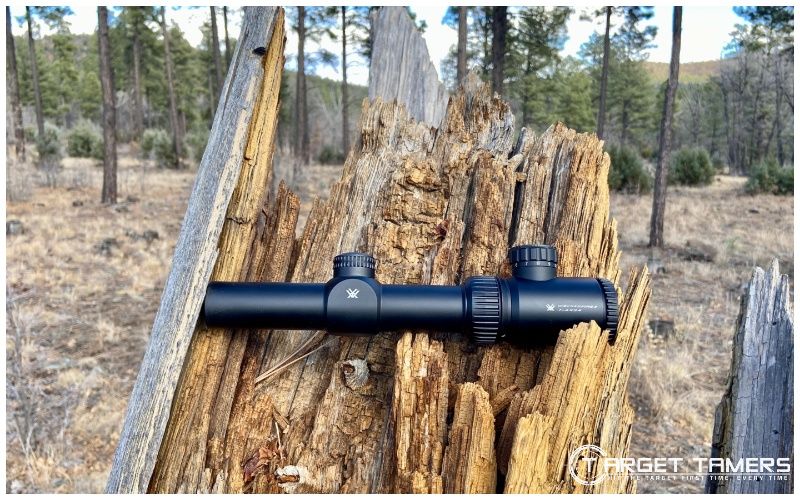
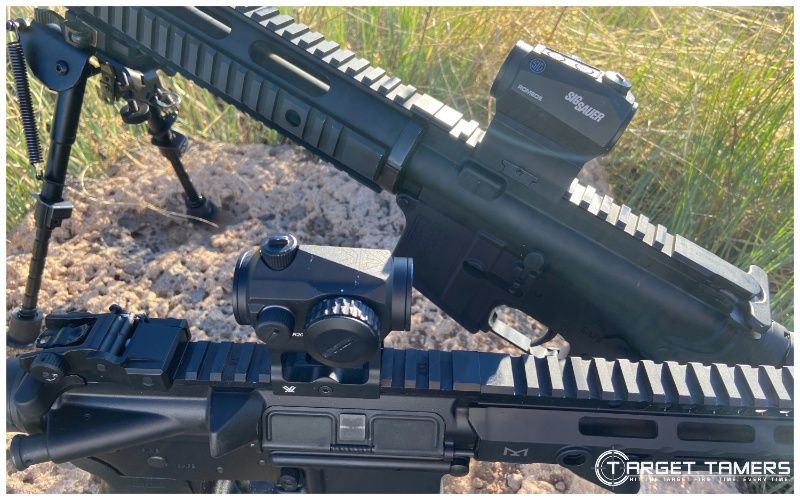
Overall, there are advantages and disadvantages to both a 1-4x scope and a red dot sight. Some factors to consider are cost, quality, size, co-witnessing, battery runtime, and much more. To discuss the differences, these considerations are compared to determine which is best for the situation.
I’ve also provided tables to demonstrate key differences between red dot sights and 1-4x LPVOs to help illustrate my point where appropriate.
Also, the suggested ‘winners’ are but suggestions. In some categories, there’s an argument for either the red dot sight or the 1-4x and you could go either way. So personal preference has weight. However, the discussion might help to narrow down some important factors you may want to consider.
For more application specific comparisons for hunting, 3-gun, AR-15, and more, put your sights on our Red Dot VS LPVO comparisons guide!
Cost
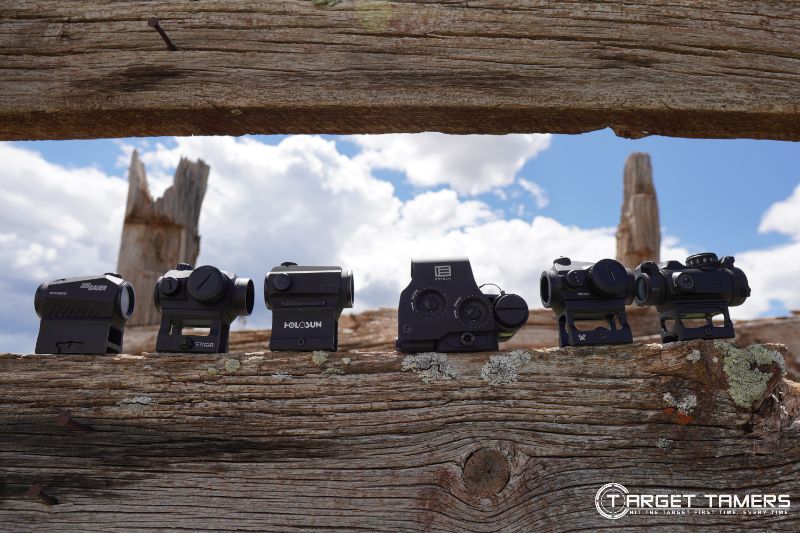
On average, red dot sights are more affordable than 1-4x scopes. As with all things optics, cost varies greatly due to contributing factors such as red dot technology, scope quality, glass elements, and more.
Though some of the best red dot sights cost between $450-$800, some of the best 1-4x scopes can cost more than $1000. If money is not an issue, there are other factors to consider, but since money is always a major part of the decision, a high-end red dot will be cheaper than a high-end LPVO.
If we were to compare the cheapest red dots with the cheapest 1-4x scopes, red dot sights will still be the economical optic. There are several red dot sights for under $50, but there will be very few in the same price range for a 1-4x. The next step up would be to consider a 1-4x scope between $50-$100.
Winner: Red dot sight
| Product | Configuration | Type | Price Range |
|---|---|---|---|
| Steiner P4Xi | 1-4x24 | LPVO | Under $1000 |
| Vortex Crossfire II | 1-4x24 | LPVO | Under $200 |
| Monstrum | 1-4x20 | LPVO | Under $100 |
| Aimpoint Pro Patrol | 1x38 | RDS | Under $500 |
| Holosun HS510C | 1x | RDS | Under $350 |
| Sig Sauer Romeo 5 | 1x20 | RDS | Under $150 |
Magnification
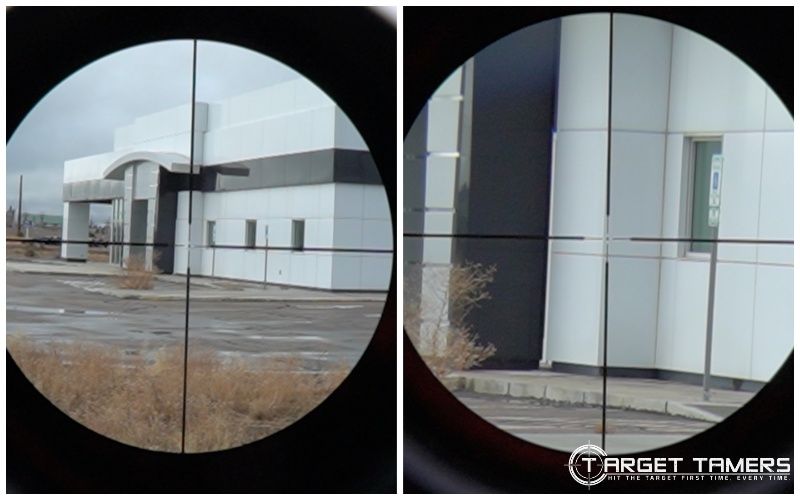
There’s legitimacy in comparing the 1-4x magnification of an LPVO and the 1x performance of a red dot sight. Since many are running 1x power on an LPVO for tactical work, why not just opt for a red dot sight and do without the possible hindrances that come with variable magnification?
I reckon it has more to do with having more magnification for when it’s needed than to be without it. For some, this might just mean zooming in for observation and identification. For others, it might give the benefit of greater accuracy when distance comes into the equation.
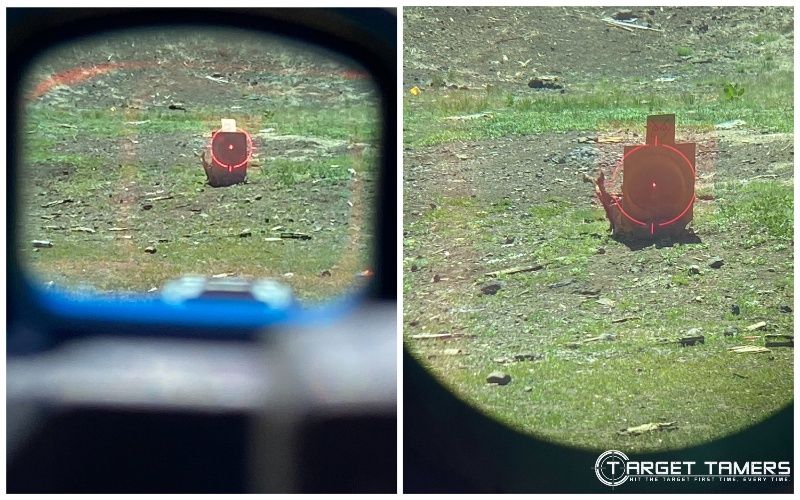
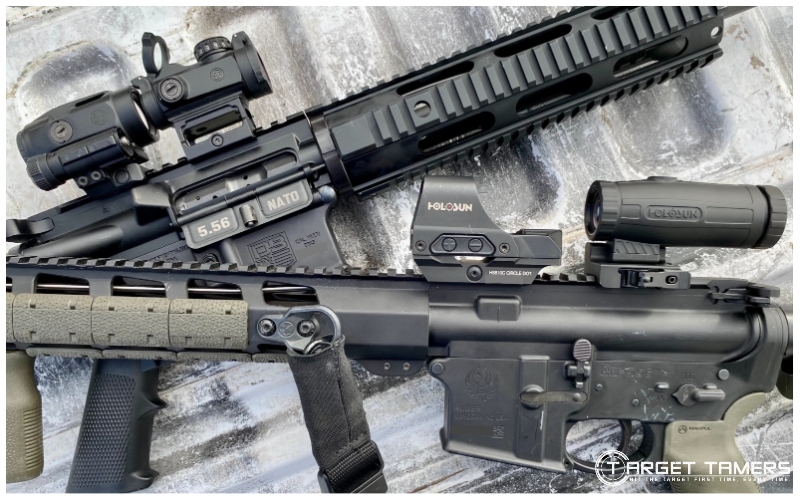
You could argue that a red dot and a magnifier would provide the same benefits. With a magnifier, you’re still dealing with fixed magnification and usually smaller eye relief than you would have with a 1-4x scope even at max power.
Something else to consider is the FOV between a magnifier and a 1-4x. Another point is that the size of the red dot increases when paired with a magnifier. That could inhibit precision at range which is essential to consider for competition and hunting.
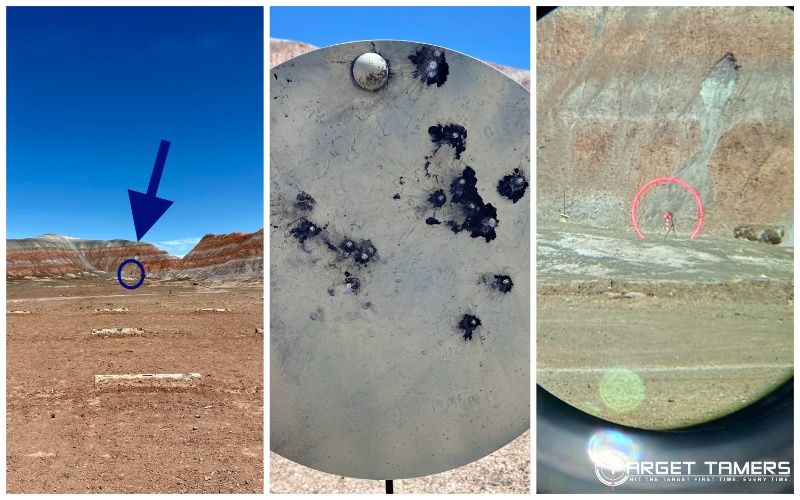
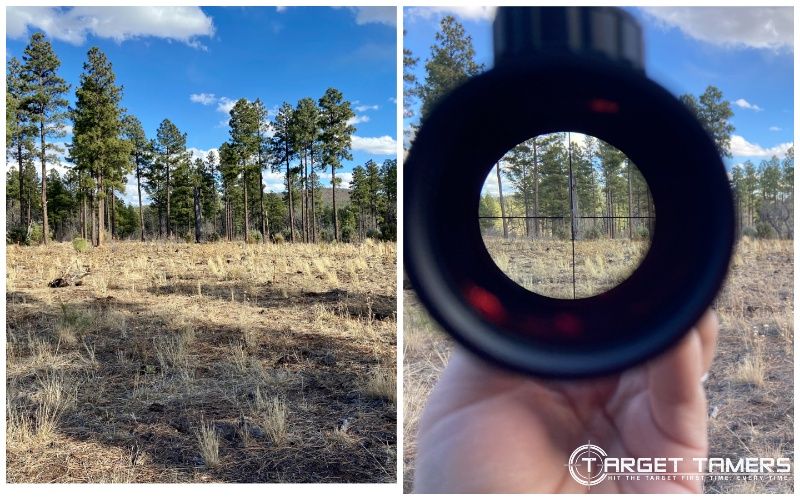
However, many 1-4x scopes will struggle to provide true 1x performance, especially if you’re looking to spend less than $500. A 1-4x scope at 1x will not be the same as a red dot sight at 1x. Usually there’s some finagling that can be done with the eyepiece and the magnification ring on a 1-4x scope to get something close to 1x performance.
Even if I feel like I don’t have the 1x performance of a red dot in a 1-4x scope, I can live with that. I love having variable power for when I want it.
Winner: 1-4x scope
| Product | Magnification | Type |
|---|---|---|
| Vortex Crossfire II* | 1-4x | LPVO |
| Tacticon Apex Falcon V2 | 1-4x | LPVO |
| STNGR Axiom II* | 1x | RDS |
| Holosun HS403B* | 1x | RDS |
| EOTech EXPS3* | 1x | Holographic sight (often compared to RDS) |
*Target Tamers field tested!
Configuration
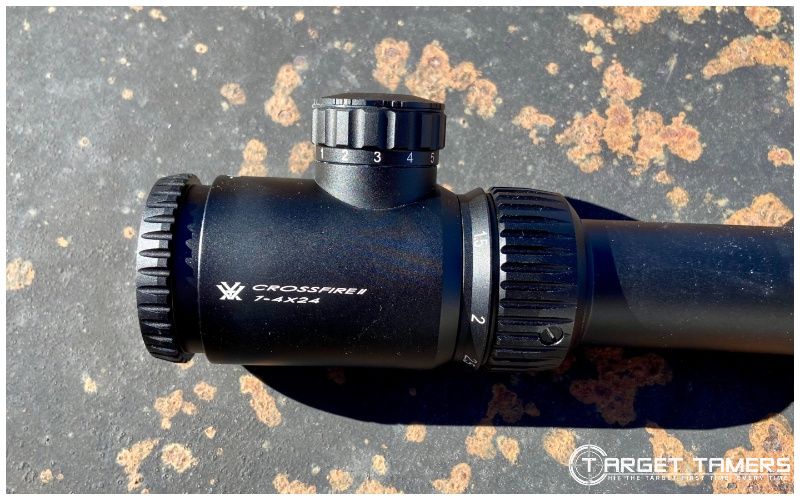
The configuration is the magnification and the objective lens size. Though a 1-4x LPVO is bigger than a red dot, they actually have similar configurations minus the variable magnification. The 1-4x scope starts at 1x power and this is supposed to be the same as an unmagnified (1x) red dot sight.
The real difference though lies in the fact that many budget LPVO scopes just cannot provide true 1x performance. The additional lenses and the way light works through a scope doesn’t really provide a sight picture that can be compared to a red dot at 1x.
In this, you could say that reflex red dot sights don’t really have ‘optical’ systems not in the way a riflescope has or even a prismatic sight. As such, red dots reign as 1x champions.
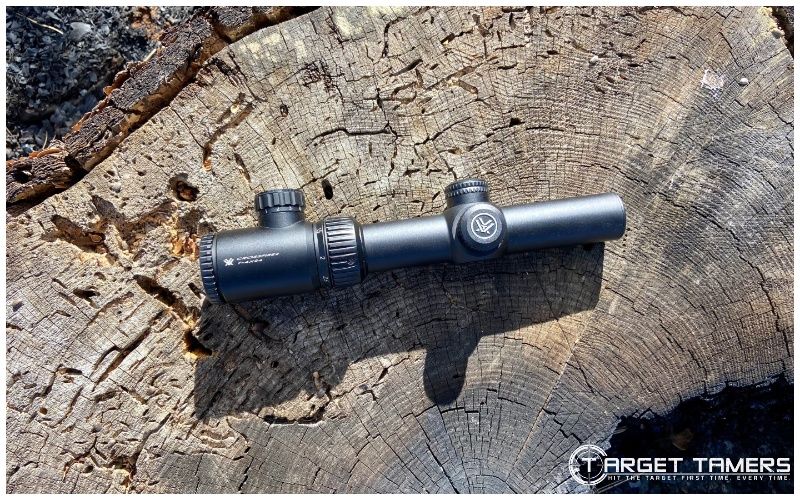
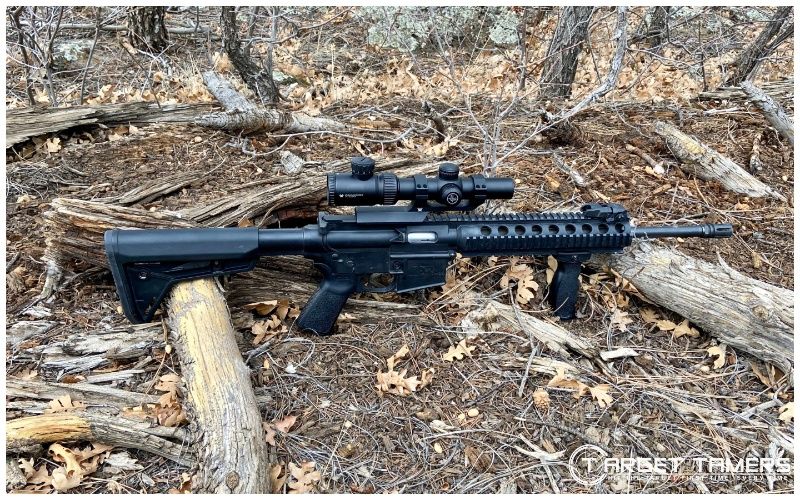
Considering the objective lens, you’ll notice that many red dot sights have 20mm objectives though they do get larger at 22mm, 24mm, 26mm, 28mm, and even 30mm. Amongst 1-4x scopes, the objective lens will either be 20mm or 24mm but there are some 28mm and 30mm scopes out there too.
The larger lens can help with providing a brighter and clearer sight picture especially during lowlight conditions.
Red dots have true 1x performance without the weight and bulk of a 1-4x LPVO, but most will have 20mm objectives.
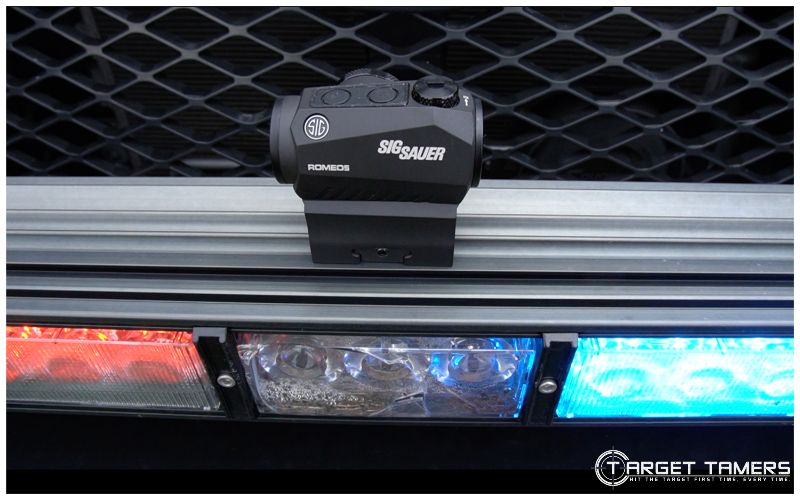
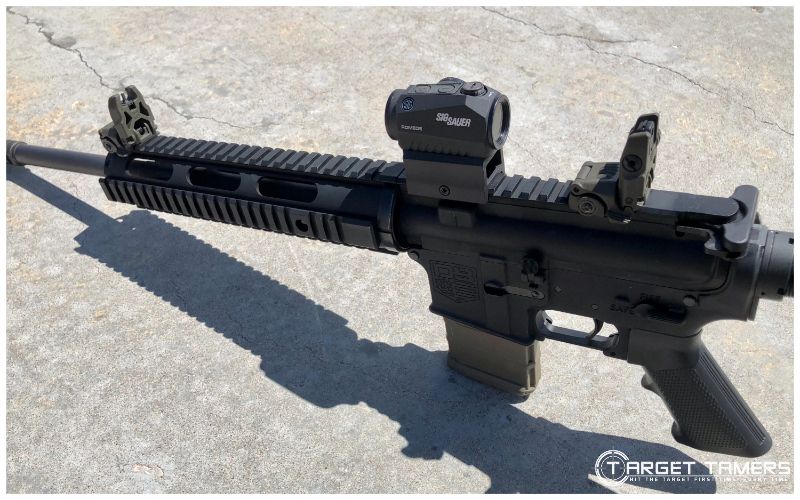
On the other hand, quality 1-4x scopes still have great 1x performance and cheaper ones can be manipulated somewhat to perform in the good-enough category without too much fish-eye or strain on the eyes. The objective lens size will be something specific to look at just like when you peruse red dot sights.
In total, the red dot does 1x better. A scope can be good enough, even great, at 1x but it also comes with the ability to do more than a red dot. It really comes down to what it is that you’re after 80-90% of the time.
Winner: Tie
| Product | Type | Magnification | Objective Lens Size |
|---|---|---|---|
| Trijicon Accupoint TR24 | LPVO | 1-4x | 24mm |
| Leupold Mark 3HD | LPVO | 1.5-4x | 20mm |
| Monstrum | LPVO | 1-4x | 20mm |
| Aimpoint Patrol PRO | RDS | 1x | 38mm |
| Sig Sauer Romeo MSR* | RDS | 1x | 20mm |
| Vortex Strikefire II* | RDS | 1x | 30mm |
*Target Tamers field tested!
CQB
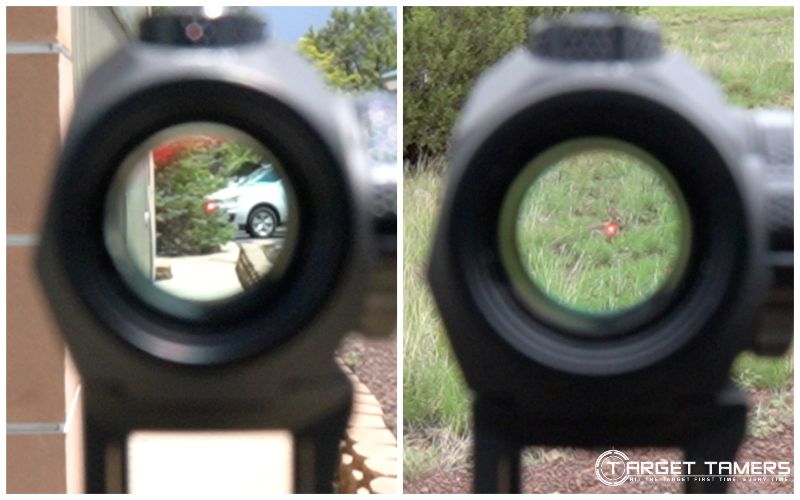
Though CQB can be considered up to 100 yards, I’m going to slim the margins and say it’s between 0-50 yards. This is plenty of distance when you’re considering close-range engagements in law enforcement, home defense, tactical drills, and more.
It’s obvious that the red dot sight is the tool for the job. At this point it’s about speed, no magnification is needed, and there needs to be a forgiving eyebox for when you’re in those awkward positions that come with clearing buildings, hallways, around doors, etc.
The red dot provides for all of that.
Winner: Red dot sight
| Product | Type | Dot Size |
|---|---|---|
| Ozark Armament Rhino* | RDS | 4 MOA |
| Sig Sauer Romeo MSR* | RDS | 2 MOA |
| Primary Arms SLx MD25 Gen II* | RDS | 1 MOA dots |
| EOTech EXPS3* | Holographic Sight | 1 MOA |
*Target Tamers field tested!
Mid to Long-Range
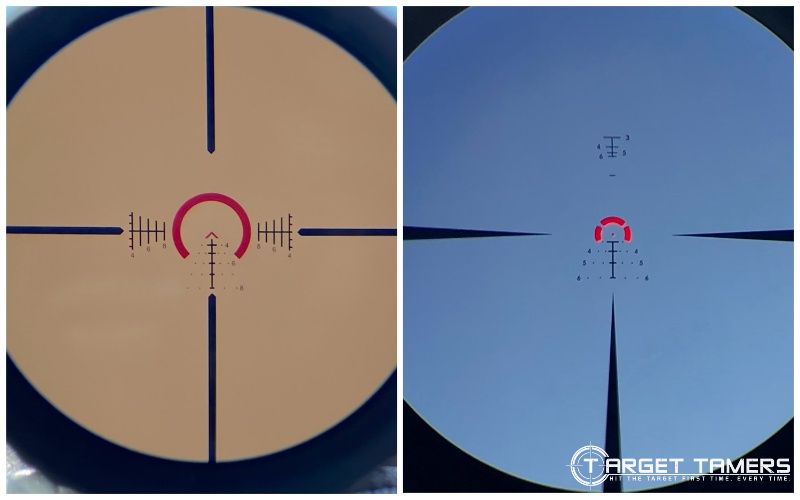
Mid to long range distances can cover 400-800 yards depending on what you’re shooting with. However, when it comes to the red dot sight and 1-4x scope, I’m going to say mid-range is about 150-250 yards and long-range is further than that.
With a red dot sight, it’s likely that one is running a 25, 50, or 100 yard zero, and with a 1-4x, you could easily run one of those zeroes too. Not a whole lot of magnification is required to reach out to 200, 300 yards, and some can do it with just a red dot sight. However, the variable magnification can make a big difference in target identification and can potentially improve precision.
Since LPVO scopes can also come with BDC reticles, they are fast to use with holdovers to go the distance. Most red dot sights have a dot reticle although there is one here and there with BDC reticles in them. However, the 1-4x scope will go the distance a lot faster and with better precision than a red dot sight.
Winner: 1-4x scope
| Product | Type | Configuration | Reticle Type | Effective Range** |
|---|---|---|---|---|
| Steiner P4Xi | LPVO | 1-4x24 | BDC | 0-600 yards |
| Vortex Crossfire II* | LPVO | 1-4x24 | Duplex | 0-200 yards |
| Primary Arms SLx MD25 Gen II* | RDS | 1x25 | BDC | 0-600 yards |
| Sig Sauer Romeo 5* | RDS | 1x20 | Dot | 0-150 yards |
*Target Tamers field tested!
**Approximation
Eye Relief
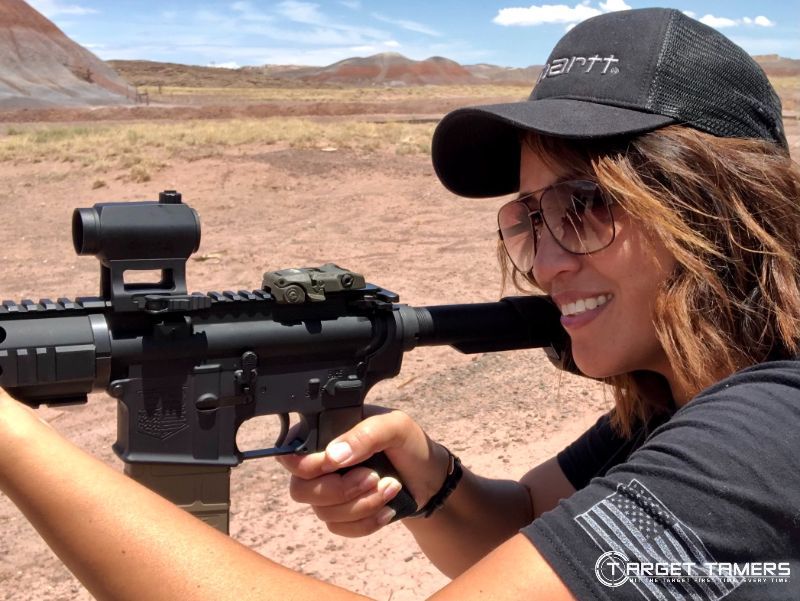
The 1-4x LPVO is a riflescope, so even though it also has 1x power, it still has the optical assemblies required for you to get within the eyebox to properly use the scope. LPVO eye relief generally ranges from about 2.5-4”.
What I commonly see is that many people don’t like the tight eyebox at max power, and it has nothing to do with scope bite. In fact, it’s about the frustration of quickly acquiring a clear sight picture at max power whether you’re in your natural position or need some flexibility for awkward positions.
This is usually the reason why I would say that if you plan on using max power often, then go to the next larger configuration LPVO. Example: if you think you need a 1-4x scope because you will often sit at 4x, then I’d recommend opting for a 1-6x. With the 1-6x, you can sit at 4x and possibly have better sight picture clarity and a more forgiving eye box.
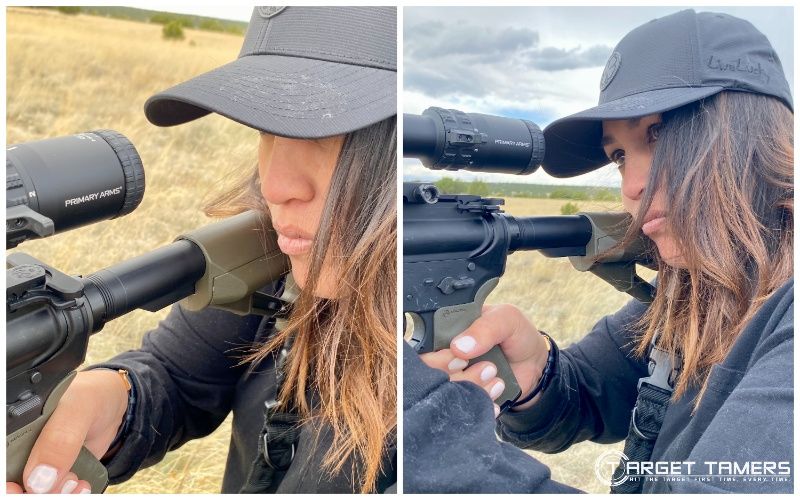
In my experience, the eye relief hasn’t been too bad at all with 1-4x, 1-6x, and 1-8x scopes. Yes, it does get a bit finicky at max power but nothing that can’t be practiced with.
In total, a red dot sight is an unmagnified optic except for fixed magnified prism scopes. With no magnification, there’s no need for set eye relief and you essentially have an unlimited field of view.
This provides the advantages of mounting the red dot sight anywhere you prefer on the rail. Generally, the further forward it is, the better situational awareness you have, and the closer it is towards your eye, the faster it is to acquire the dot and the target.
Winner: Red dot sight
| Product | Type | Configuration | Eye Relief |
|---|---|---|---|
| Bushnell TRS-25* | RDS | 1x20 | Unlimited |
| Vortex Crossfire II* | RDS | 1x20 | Unlimited |
| Ozark Rhino 4X* | Prism RDS | 4x32 | 3.5” |
| Vortex Crossfire II* | LPVO | 1-4x24 | 4” |
| Trijicon Accupoint TR24 | LPVO | 1-4x24 | 3.2” |
| Monstrum | LPVO | 1-4x20 | 3.8-3.5” |
*Target Tamers field tested!
Accuracy
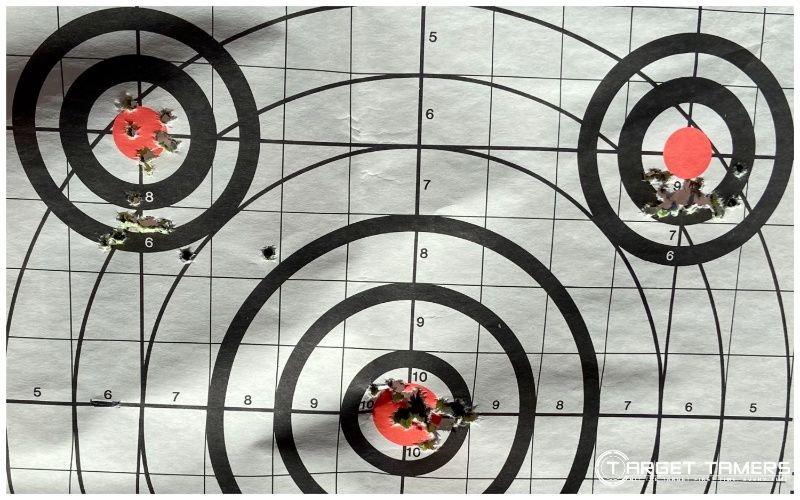
In general, red dot sights typically have 0.5 or 1 MOA adjustments. LPVO riflescopes usually have 0.25 MOA, 0.5 MOA, or 0.1 MIL adjustments. The smaller adjustments and smaller subtension that comes with crosshairs in a 1-4x scope can provide more accuracy than a red dot sight.
Hitting paper and steel targets at 25 yards or 200 yards is child’s play for the LPVO or the red dot sight. However, if you’re looking for maximum precision, it’s more likely you’ll achieve that with a riflescope over a red dot sight.
Winner: 1-4x scope
| Product | Type | Configuration | Reticle Type | Adjustment Value |
|---|---|---|---|---|
| EOTech EXPS3* | Holographic Sight | 1x | 1 MOA dot w/68 MOA ring | 0.5 MOA |
| Holosun HS403B* | RDS | 1x20 | 2 MOA dot | 0.5 MOA |
| Vortex Crossfire II* | RDS | 1x20 | 2 MOA dot | 1 MOA |
| Vortex Crossfire II* | LPVO | 1-4x24 | V-Brite | 0.5 MOA |
| Trijicon Accupoint TR24 | LPVO | 1-4x24 | Triangle Post | 0.25 MOA |
*Target Tamers field tested!
Speed
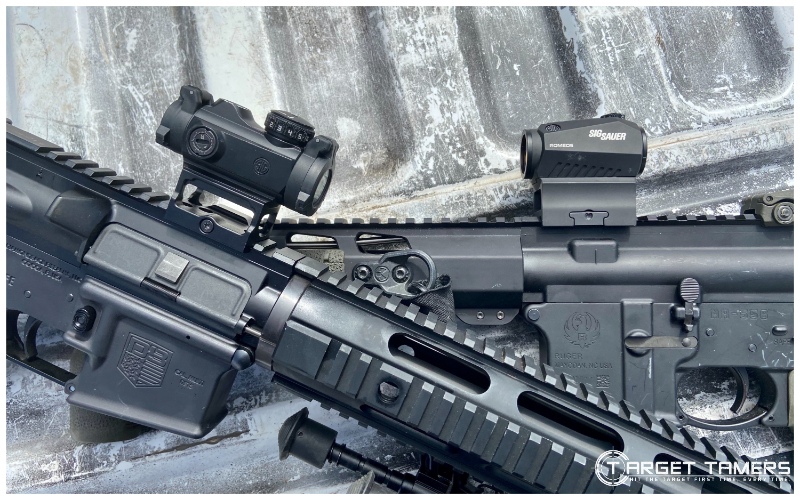
On average, the red dot sight will unarguably be faster to use than a 1-4x scope. With a larger dot, no eye relief to deal with, and essentially a ‘parallax free’ optical system, you can hit your target as fast as you can pull the trigger.
I’ve seen timed shots comparing the performance of an LPVO and red dot sight with and without a magnifier, and it’s impressive. Times are close but some shooters can be faster with a 1-4x scope. I’m not one of those people… are you?
Then there’s also the relationship between speed and precision. A 1-4x LPV can cover both needs, but a scope does come with bulk and weight. Depending on your setup, you can accommodate and train for that.
Depending on various factors like distance, target size, position, terrain, and the conditions, etc., I’m sure a 1-4x LPVO can adequately compete with a red dot sight. But in most hands, the red dot sight will be faster to use.
Winner: Red dot sight
Reliability
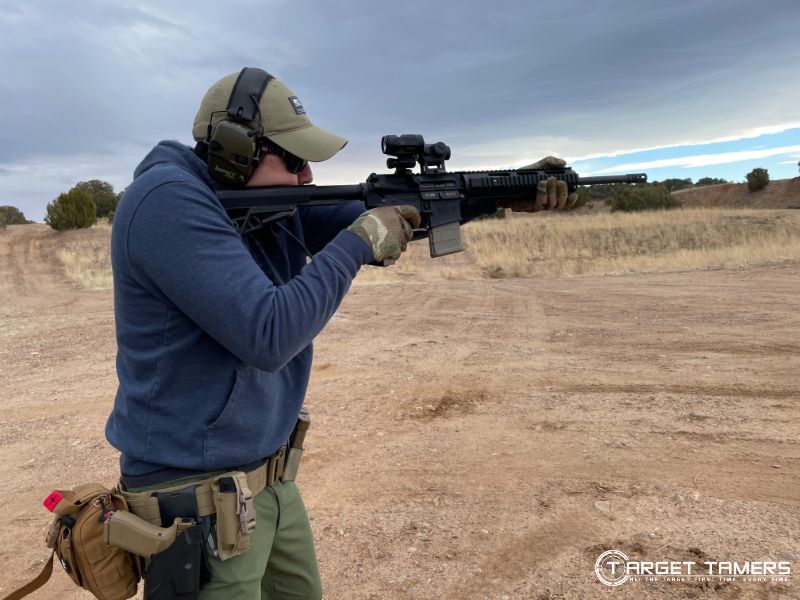
Judging reliability is different than judging the build quality of an optic. I specifically look at ease of use, visible references/markings, zero retention, readiness, and more. When comparing a red dot and a 1-4x LPVO for reliability, they share similarities but then differ in some important ways.
One of the first things that comes to mind is readiness. There are red dot sights with 50,000-hour battery runtimes for continuous-on operation. There are also red dots with motion sensor technology to conserve battery life and then automatically activate when motion is detected.
Obviously, a red dot sight requires a power source to be functional. While many red dots operate flawlessly, there is the concern that the illumination system can fail. When this happens, the red dot is unusable.
Since a 1-4x LPVO is a scope, it has a black reticle. Glass-etched reticles are popular in LPVOs and they’re always ready even without illumination. If the battery dies, you can still see your reticle and therefore still use the scope. I’d count this is a reliable feature.
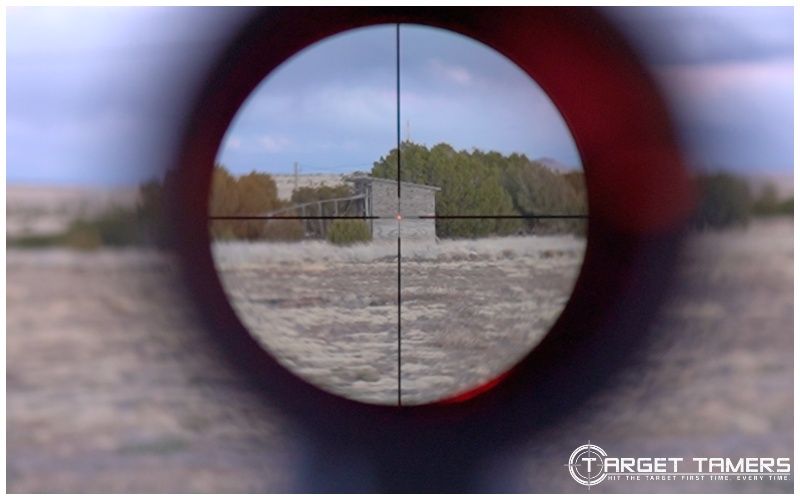
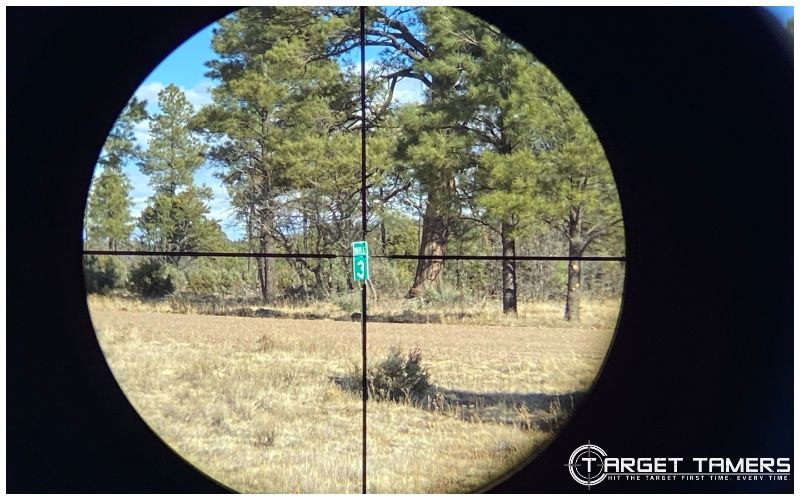
Zero retention, ease of use, and visible markings are optic specific, so it’s not as easy to generalize for the purposes of comparing. To attempt it, I’d say there’s little demand from a red dot sight to take your eyes off the sight picture. An illumination knob or buttons can be manipulated easily. They can handle abuse and there’s no argument that they’re incredibly easy to use. The included mounts are usually good enough to help retain zero.

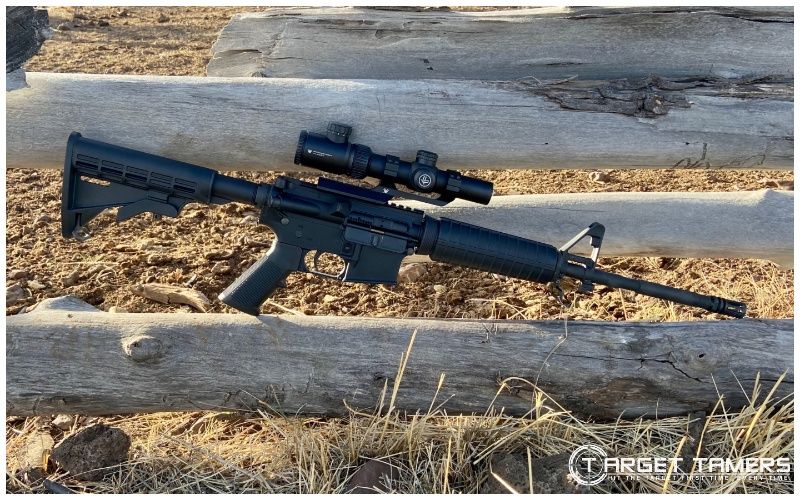
With a 1-4x scope, there’s a little more going on that could demand your attention. If there’s a side focus, you need to manipulate that for maximum clarity and reduce parallax effects, you usually can’t see the illumination or magnification references without leaving the sight picture, and though good scopes hold their zero, you’ll need to purchase a quality mount to ensure it remains so. As precision optical instruments, there’s a bit more concern about its durability to handle abuse.
Even with these comparisons if all things were equal (zero retention, ease of use, durability, etc.) between a red dot and a 1-4x scope, I think the fact that the 1-4x scope will always provide a visible reticle with or without illumination is a major advantage.
Winner: 1-4x scope
Astigmatism
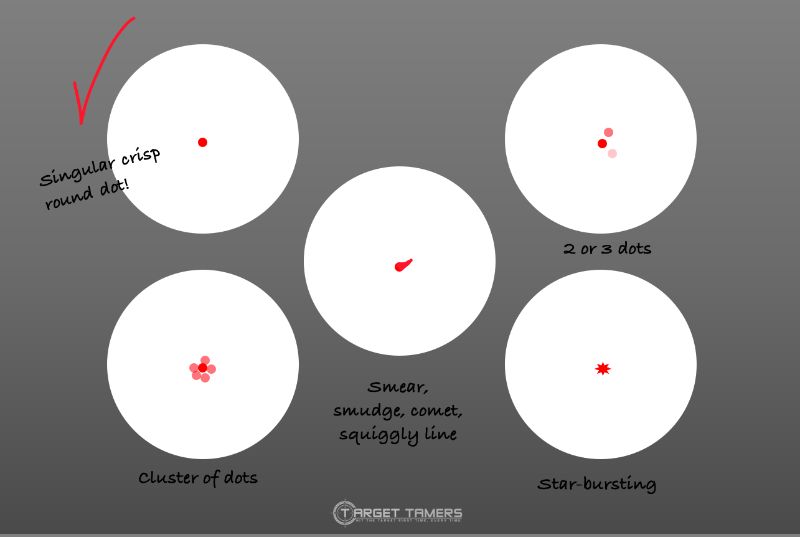
If you have astigmatism, are near or far sighted, or you have presbyopia (age-related), you probably don’t see a dot as a dot in a red dot sight. It could look like two dots, a cluster of dots, a star, or a comet. It’s not the red dot sight, it’s you.
This has to do with the way your eyes focus light. Since you’re essentially counting on a reflection of an LED light to provide a round dot, your eyes won’t like it. Those with astigmatism may do better with a prism red dot sight if you must stay in the red dot sight family.
But many, especially those with old eyes, will opt for the reticle visibility of a riflescope. The physicality of wire or glass-etched crosshairs are easier for the eyes to focus, and since a 1-4x scope has an adjustable eyepiece to sharpen the reticle for your eyes, the scope wins out.
Winner: 1-4x scope
Size/Weight
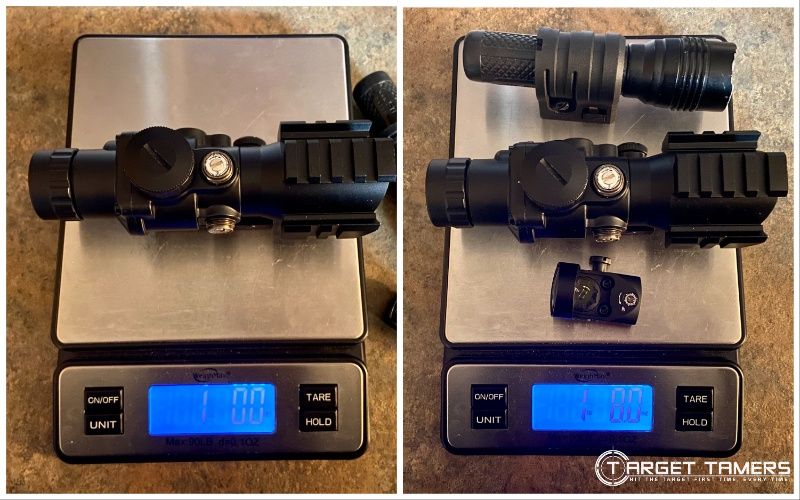
Even though the 1-4x scope is the smallest in the LPVO family, it’s still a riflescope and is larger, longer, and heavier than red dots. The red dot sight is irrefutably compact and lightweight.
You can fit a lot more on the rail with a red dot sight, i.e., if you’re installing BUIS and/or a magnifier. That total setup could still possibly come in lighter in weight than an LPVO.
With a 1-4x, you could consider offset irons, but a magnifier is redundant. So, for the benefit of having variable magnification, you must compromise with the inherent bulk and weight.
Winner: Red dot sight
| Product | Type | Tube Size | Length | Weight |
|---|---|---|---|---|
| Vortex Crossfire II* | LPVO | 30mm | 9.61” | 14.8 oz |
| Steiner P4Xi | LPVO | 30mm | 10.3” | 17.3 oz |
| Monstrum | LPVO | 1” | 8.5” | 11 oz |
| Ozark Armament Rhino* | RDS | 30mm | 5” | 9.6 oz |
| Sig Sauer Romeo 5* | RDS | N/A | 2.4” | 5.1 oz |
| STNGR Axiom II* | RDS | N/A | 2.5” | 6.1 oz |
*Target Tamers field tested!
Illumination & Battery Life
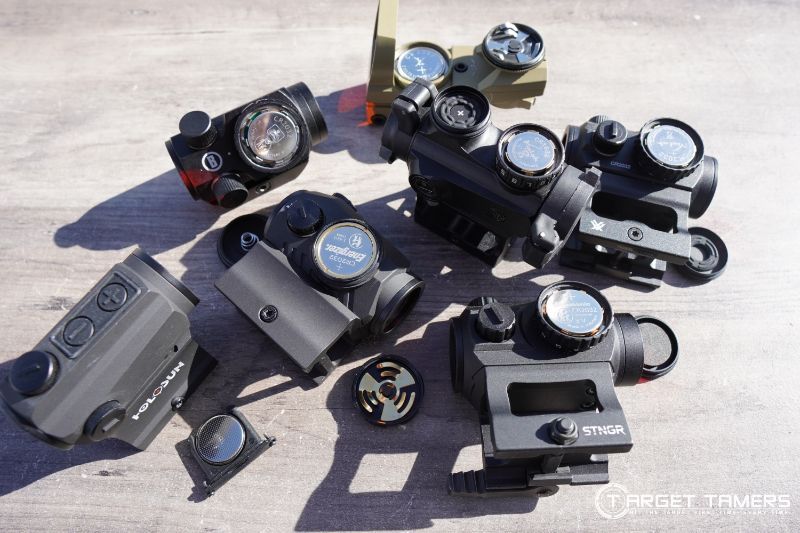
In my experience the illumination system in an LPVO, whether it’s a 1-4x, 1-6x, or 1-8x, is inferior to the illumination in a red dot sight. The red dot sight has much brighter illumination and a battery life that lasts far longer than in a riflescope.
I’ve yet to come across an LPVO that can compete with the consistently bright illumination of a red dot sight, however, it will be different between various 1-4x scopes. Take for example the Steiner P4Xi with great illumination and the Vortex Crossfire II 1-4x that is barely, if at all, visible in outdoor daylight conditions.
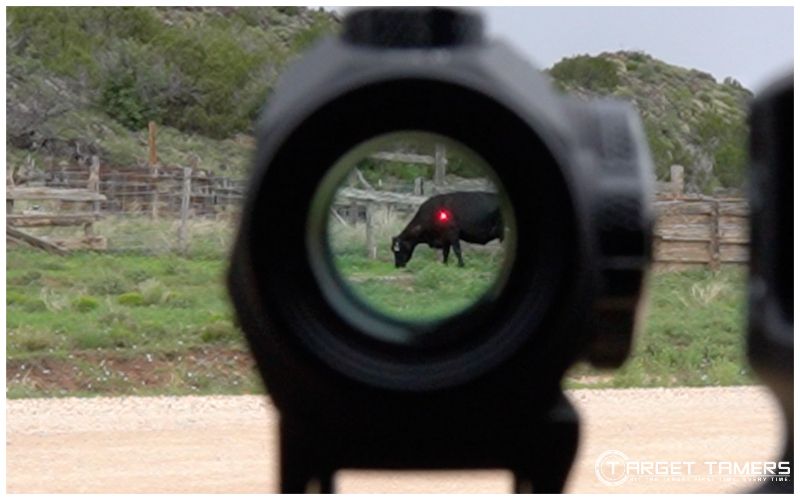
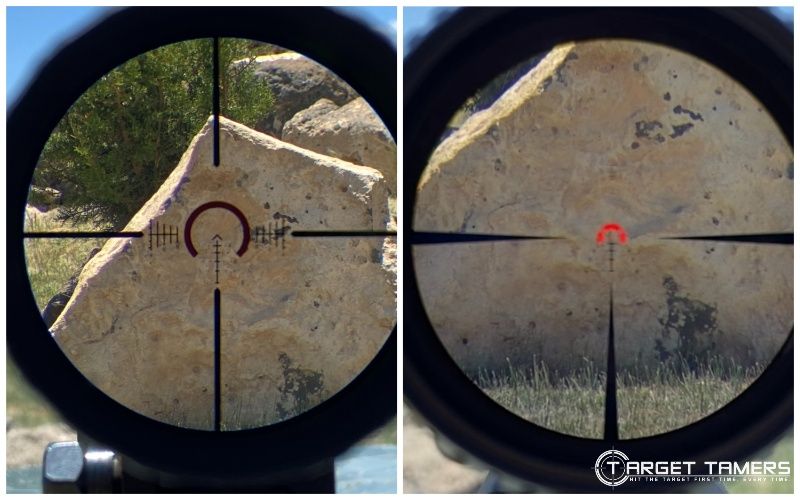
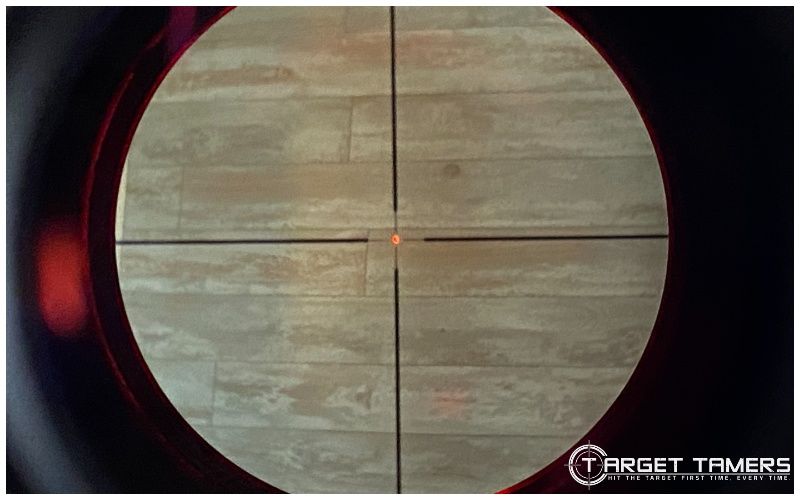
Many cheap red dots will perform excellently in daylight conditions even if they’re not ‘daylight bright.’ It’s getting them dim enough for indoor use or dark conditions that’s the real test. From hands-on testing, many red dot sights are adequately dim enough for low light though some are still too bright.
The battery life in an LPVO will probably last between 300-600 hours on average. The battery life in a red dot sight can last anywhere between 2000 hours to 50,000 hours. Many of these are continuous-on red dots, so you don’t have to remember to turn them off – they’re always ready.
I think it’s clear that the red dot sight is brighter, can be dim enough for low light, and has a longer lasting battery life than a 1-4x scope.
Winner: Red dot sight
| Product | Type | Battery Runtime | Battery Type |
|---|---|---|---|
| EOTech EXSP3* | Holographic Sight | 1000 hours | CR123A |
| Sig Sauer Romeo MSR* | RDS | 20,000+ hours | CR1632 |
| Holosun HS403B* | RDS | 50,000 hours | CR2032 |
| Vortex Crossfire II* | LPVO | 300-600 hours | CR2032 |
| Trijicon Accupoint TR24 | LPVO | TBD – fiber optics & tritium | N/A |
*Target Tamers field tested!
Co-Witness
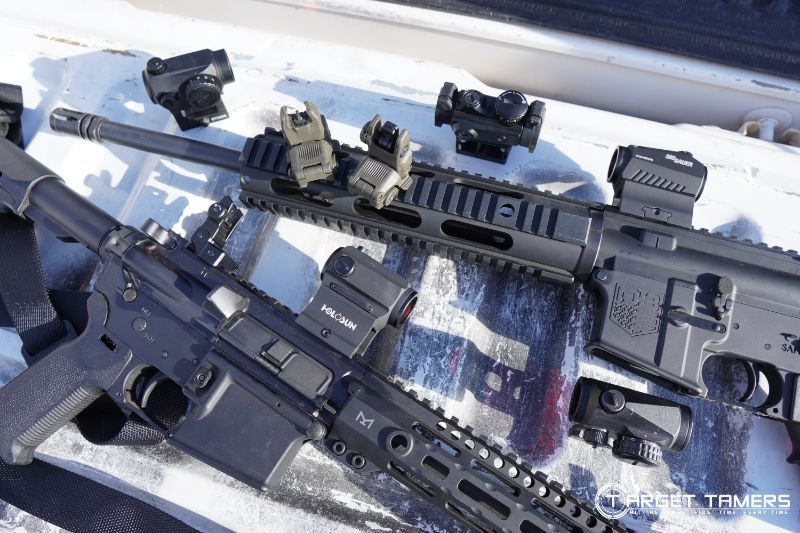
There’s really no reason to co-witness iron sights including BUIS, MBUS, whatever it is that you use on your setup with an LPVO. Even if you did have a 1-4x scope with true 1x performance, you’d need to have enough room on the rear of the rail for the rear sight. This space is typically taken up by the LPVO since it requires a set amount of eye relief.
Secondly, the way magnified scopes work, you won’t be able to acquire focus between the rear sight, front sight, and the target through scope. So, while you can see a front sight through a 1-4x at 1x power, it will look blurry.
The recommendation to have irons when you have a 1-4x LPV is to have them offset to the scope. 45-degree angle mounts would provide this benefit.
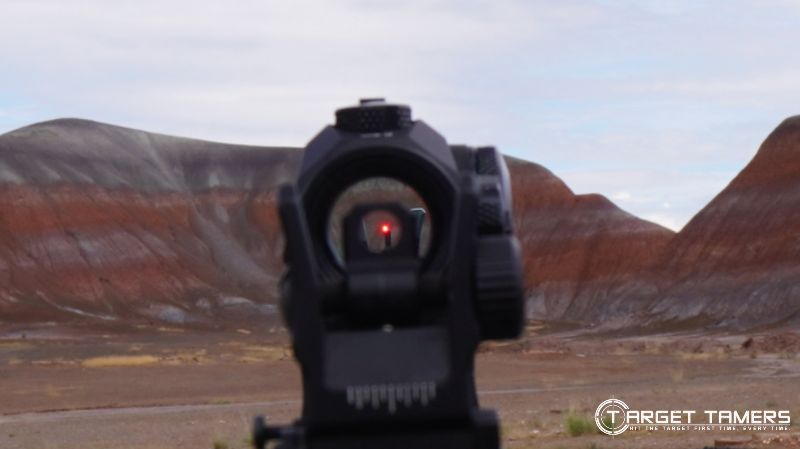

With a non-magnified sight picture and unlimited eye relief, you can co-witness your red dot sight with your sights. If you run a magnifier on your rail as well, the magnifier would need to be disengaged.
If you’re insistent on having a secondary sighting system on the same plane as your optic, a red dot sight is it.
Winner: Red dot sight
| Product | Type | Included Mounts | Co-Witness |
|---|---|---|---|
| Sig Sauer Romeo MSR* | RDS | 1.41” riser mount | Absolute |
| Holosun HS403B* | RDS | Riser & low-profile mounts | Lower 1/3 |
| Vortex Strikefire II* | RDS | 30mm cantilever mount | Lower 1/3 |
1-4x Scope VS Red Dot Sight
1-4x Scope Pros & Cons
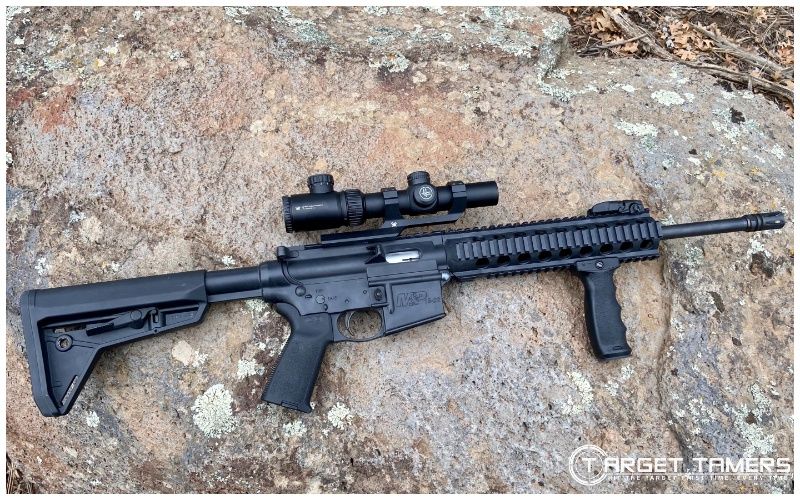
Pros:
- Variable 1-4x magnification
- Close to mid-range use
- Reticle options
- Visible reticle without illumination
- Can be better for astigmatism
- Improved accuracy
- Always instantly ready
Cons:
- Mounting is more difficult than RDS mounting
- Mount is usually purchased separately
- Likely not true 1x performance
- Set eye relief with tight eyebox at 4x
- Larger & heavier than red dots
Red Dot Sight Pros & Cons
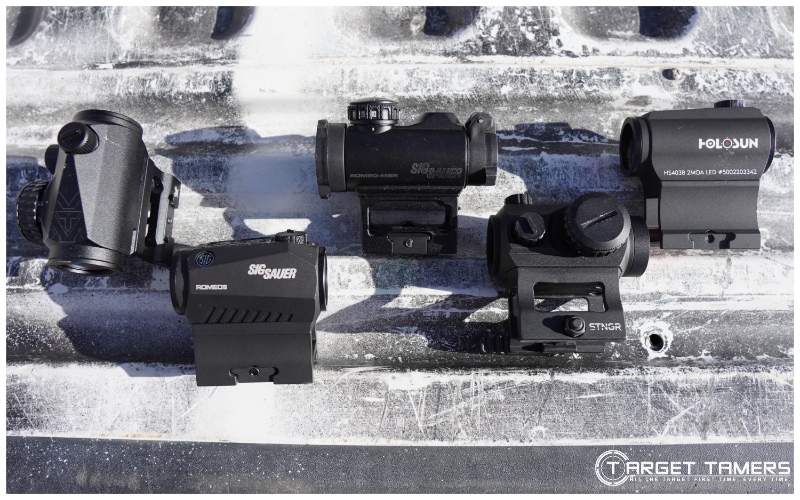
Pros:
- Fast and easy to use
- Cheaper than a 1-4x
- Easy to use MOA dot
- Unlimited eye relief & FOV
- Can use with additional optics (magnifier & BUIS)
- Mount is usually included and pre-installed
- Can be mounted on pistols, rifles, and shotguns
- Lightweight/compact
- More forgiving to use in awkward positions
- Long lasting battery life
Cons:
- Requires a power source to function
- No magnification
- Not for mid or long ranges
Which is Best for You: Red Dot VS 1-4x
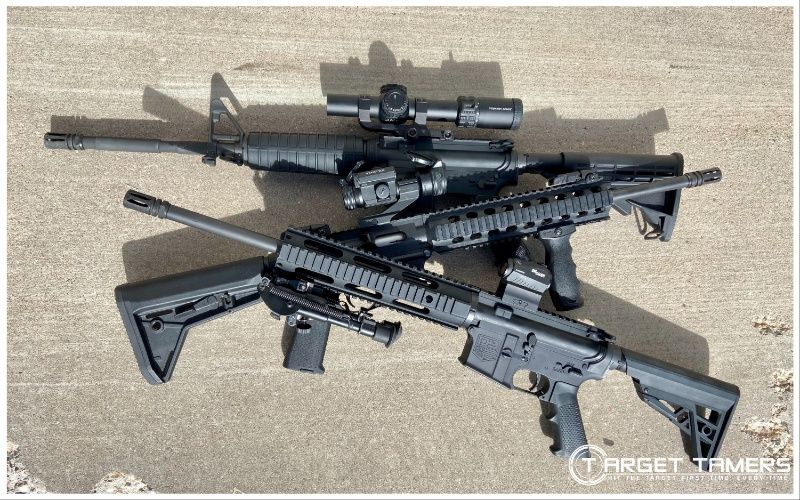
Overall, a red dot sight and a 1-4x scope are very different optics with contrasting aiming systems and technologies. The red dot sight is the cheaper option, but you can spend a little more for low, variable power for distance shots and crank it back to 1x for tactical work.
For close-range work inside 50 yards 90% of the time, I’d recommend a red dot sight for most applications especially for fast-moving engagements. A magnifier can add some versatility and BUIS will serve in the capacity for what it’s named for – back-up in case of red dot failure.
For those with visual acuity issues, those who will stretch the distance now and then, and even for CQB engagements between 25-75 yards, I’d recommend the 1-4x LPVO for increased precision. It will always be ready for action when you are since it doesn’t require a power source to operate.
I’d say whichever route you decide to go, a lot of training will help with what are initially weaknesses. You’ll be able to make it work for most of your needs.
Further Reading



